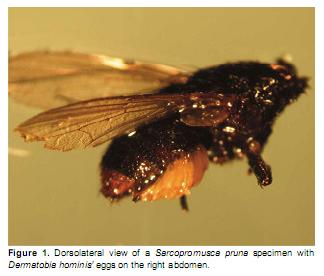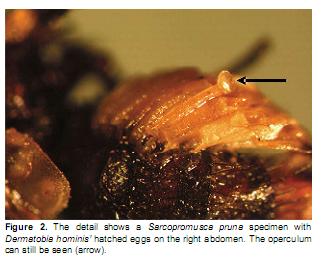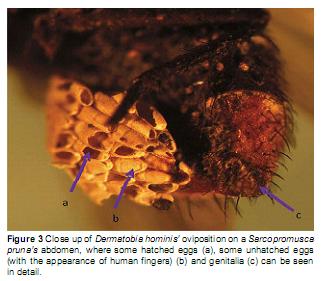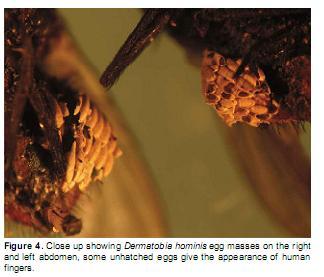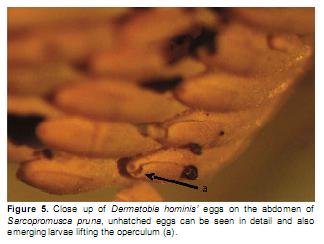Services on Demand
Journal
Article
Indicators
-
 Cited by SciELO
Cited by SciELO -
 Access statistics
Access statistics
Related links
-
 Cited by Google
Cited by Google -
 Similars in
SciELO
Similars in
SciELO -
 Similars in Google
Similars in Google
Share
Revista Colombiana de Ciencias Pecuarias
Print version ISSN 0120-0690On-line version ISSN 2256-2958
Rev Colom Cienc Pecua vol.24 no.4 Medellín Oct./Dec. 2011
Artículos originales
Sarcopromusca pruna (Diptera: Muscidae): phoretic for Dermatobia hominis (Diptera: Cuterebridae) eggs in Colombia ¤
Sarcopromusca pruna (Diptera: Muscidae): forético para los huevos de Dermatobia hominis (Diptera: Cuterebridae) en Colombia
Sarcopromusca pruna (Diptera: Muscidae): forético para os ovos de Dermatobia hominis (Diptera: Cuterebridae) na Colômbia
Edison A Cardona Zuluaga1, MV, MSc, est PhD
1Docente de Parasitología Veterinaria. Grupo de investigación INCA-CES; Universidad CES, Medellín, Colombia
(Recibido: 18 julio, 2011; aceptado: 25 octubre, 2011)
Summary
Objective: the finding of Sarcopromusca pruna as a phoretic for Dermatobia hominis eggs is described here. The later is a frequent cattle ectoparasite (human botfly) known as "nuche" in Colombia. Methods: the phoretic flies were captured in a village at San Rafael municipality (Antioquia) using Malaise-typetraps installed during the months of June to August, 2004. Each Sarcopromusca specimen carried a minimum of 19 and, in some cases, up to 23 eggs of D. hominis on the right or left side of the abdominal region. Results and conclusion:This is a new report of Sarcopromusca pruna behaving as a phoretic fly for Dermatobia hominis eggs observed in Colombia.
Key words: Dermatobia hominis, "human botfly", Muscidae, Oestridae, phoretic insects, Sarcopromusca pruna.
Resumen
Objetivo: Se describe el hallazgo de Sarcopromusca pruna (S. pruna) como forético de huevos Dermatobia hominis (D. hominis) ectoparásito comúnmente conocido en Colombia como "nuche". Metódo: las moscas foréticas fueron capturadas en una vereda del municipio de San Rafael (Antioquia) usando trampas de intercepción tipo Malaise instaladas durante los meses de junio a agosto de 2004. Cada espécimen de Sarcopromusca transportaba un número mínimo de 19 y en algunos casos hasta 23 huevos de D. hominis en el lado derecho o en el izquierdo de la región abdominal. Resultados y conclusión: este es un nuevo reporte de S. pruna como forético de huevos de Dermatobia hominis en Colombia.
Palabras clave: Dermatobia hominis, insectos foréticos, Muscidae, Nuche, Oestridae, Sarcopromusca pruna.
Resumo
Objetivo: relatamos a descoberta de Sarcopromusca pruna (S. pruna) como forético dos ovos de Dermatobia hominis (D. hominis), ectoparasita comumente conhecido na Colômbia como "nuche" e no Brasil como "mosca-varejeira". Métodos: as moscas foréticas foram capturadas no município de San Rafael (Antioquia), utilizando armadilhas de intercepção tipo Malaise instaladas durante os meses de junho a agosto de 2004. Cada espécime Sarcopromusca carregava entre 19 e 23 ovos de D. hominis no lado direito ou esquerdo da região abdominal. Resultados y conclusões: este é um novo reporte da S. pruna como forético de ovos de Dermatobia hominis na Colômbia.
Palavras chave: insetos foréticos, Oestridae, parasita.
¤ To cite this article: Cardona EA. Sarcopromusca pruna (Diptera: Muscidae): phoretic for Dermatobia hominis (Diptera: Cuterebridae) eggs in Colombia. Rev Colomb Cienc Pecu 2011; 24:577-584
* Corresponding author: Edison Alberto Cardona. Calle 10A # 22-04 | Medellín, Colombia. Tel: (57) (4) 444 0555 Ext. 1448 | Fax: (57) (4) 311 35 05, Universidad CES, Medellín, Colombia. E-mail: ecardonaz@ces.edu.co, ediscar08@hotmail.com.
Introduction
Dermatobia hominis (Linnaeus, 1781) previously called D. ovaniventris (D. cyaniventris) is a fly in the Oestridae family, which in Neotropical America is distributed from northern Mexico to northern Argentina. In its larval stages it mainly affects cattle, dogs and man, which makes it a major public health problem in tropical and subtropical America. Nonetheless, it can also parasitize cats, sheep, rabbits and other animals. (Ribeiro et al., 2001; Guimarães, 1998; Aiello, 1998; Saavedra y Schenone, 1998; Sancho, 1988; Acha y Szyfris, 1986). The Dermatobia larvae cause myiasis boils or dermatobiosis, which is characterized by the formation of subcutaneous nodules in the host, with one or more larvae inside them. Such myiasis is known under different names, depending on the region or country. For example, in Colombia, is called grub or "nuche", in Brazil "berne" and in Ecuador "tupe". In Bolivia it is called "hairy worm" while in Argentina, Uruguay and Paraguay is called "ura". In Peru is known as "mirunta", in Venezuela is called "macaca worm", in Mexico and Guatemala "moyocuil" or "colmoyote". In English-it is known as "human botfly". (Clyti et al; 2008; Guimarães and Papavero, 1998; Gomes et al., 1998; Fortes, 1997; Urquhart et al., 1990).
The D. hominis larvae remain on cattle for a period of 40 to 60 days, during which they cause significant damage to the skins, reducing their commercial value. (Gomes et al., 1988; Moya, 1982; Jobsen y Mourier, 1972). Losses caused by the D. hominis larvae in cattle are reflected by a low milk production, decreased weight gain and therefore meat production. Leather is the product that undergoes a higher depreciation, leading to a decreased commercial value, as the larvae are usually located in the skin areas with more value for the leather industry, which makes it unusable up to a 70%. (Grisi et al., 2002; Ribeiro et al., 2001; Aiello, 1998; Oliveira, 1991; Sancho E, 1988; Gomes et al., 1988). These authors estimate that the Brazilian livestock industry, for example suffers an annual loss of around $ 250 million due to the action of D. hominis.
In the adult fly, the mouthparts are atrophied and therefore it does not feed, getting its nourishment only from food reserves accumulated during the parasite stage. (Grisi et al., 2002; Pinto et al., 2002; Sancho, 1988).
Females do not lay eggs directly on vertebrates tissues, but on other blood-sucking arthropods, (mainly smaller flies and mosquitoes) caught in flight and on which abdomens they deposits and adhere accumulations of eggs, such transportation phenomena is called phoresy and the vehicles are known as phoretic. This particular feature of using other diptera to carry their eggs was first recorded in Brazil by Raphael Morales (1911) cited by Neiva and Gomes (1917).
There are more than 50 identified species of Diptera belonging to the families Muscidae, Culicidae, Simuliidae, Anthomyiidae, Tabanidae, Fanniidae, Sarcophagidae, Calliphoridae and Cuterebridae as phoretic on D. hominis. However, Sarcopromusca pruna, Stomoxys calcitrans, Musca domestica, Fannia pussio and Haematobia irritans are considered the most important species in transporting D. hominis eggs (Azevedo et al., 2007; Gomes et al., 2002; Silva et al. 1999; Guimarães y Papavero,1998; Moya, 1982).
In southern Brazil Fannia tumidifemur (Diptera: Fanniidae) has been reported as a vector of D. hominis eggs in Paraná by Pinto et al. (2002); F. heydenii (Diptera: Fanniidae), M. domestica (Diptera: Muscidae) and Morellia humeralis (Diptera: Muscidae) in Santa Catarina by Paloshi et al. (1991). Finally Ribeiro et al. (1985) and Brum et al. (1998) reported in Rio Grande do Sul S. calcitrans, M. domestica and F. punctipennis as vectors of eggs of D. hominis.
According to Silva et al, 1999, Sarcopromusca pruna, Musca domestica, S. calcitrans, H. irritans, Hydrotaea aenecens and Fannia spp, have been identified as the most important vectors of D. hominis eggs under field conditions in Brazil. While other dipterans such as Cochliomyia macellaria, C. hominivorax, Chrysomya albiceps and C. putoria, have been found less often carrying this fly's eggs (Paloschi et al., 1991; Oliveira, 1986; Maia and Gomes, 1988).
S. pruna, S. calcitrans, M. domestica, Fannia pusio and H. irritans are considered the most important species transporting this ectoparasite's eggs in several tropical countries (Gomes et al., 2002; Silva and Moya, 1999, Guimarães and Papavero, 1998; Sancho, 1988).
According to Neel (1955) and Zeledon (1979), an average of 27 insects was reported as D. hominis eggs carriers in Costa Rica. In Colombia, Bates (1943) studied the oviposition behavior of D. hominis, on different diptera species and found that the vectors must have zoophilic habits, be diurnal, of moderate activity, and similar or slightly smaller in size than Dermatobia. This research, similarly to that of Mateus in 1967, describes the vector species involved in the life cycle of this ectoparasite in some regions of Colombia. In Brazil, work performed by Oliveira(1986); Maia and Gomes (1988), Paloschi et al., (1991), Brum et al., (1996), Gomes et al., (1998), Rodriguez (1998), Guimarães and Papavero (1998), and more recently, Azevedo et al., (2007) reported diptera species involved so far in D. hominis life cycle.
Therefore, the importance of some Muscidae in transporting D. hominis eggs in tropical countries is quite evident. The scarce and outdated research performed in this regard in Colombia, motivated the development of the present study, with the aim of identifying the main Muscidae genres and species, acting as phoretic of D. hominis in an enzootic region of Antioquia, and further comparing them with those in other areas in the Department and the country.
Materials and methods
Type of study What performed a cross sectional descriptive study, using the Malaise interception system to trap diptera from different families, looking for possible transporters of D. hominis eggs.
Methods Catches were made in a village in the municipality of San Rafael. This municipality is located in the Eastern sub-region of Antioquia, 104 miles from Medellin, latitude: 6° 18‘ N, length: 75º 01' W and at 1,000 above sea level. The climate is temperate and the municipality has an average temperature of 23 ºC (Gobernación de Antioquia, 1991)
Here as well as in other villages of the municipality, traditional and artisanal double purpose livestock has been practiced, stocking about two animals per hectare in native grass. Due to the fact that adult flies of D. hominis inhabit semiforested areas, we selected two pastures on the same farm that were close to shrubs (semi-forested areas) with highly infested cattle. The parasite burden was diagnosed quantitatively by inspection, counting the number of nodules by live larvae on the subcutaneous tissue, on the second and third instars, with the corresponding characteristic exudates. I observed animals with an average infestation of 15 to 36 active boils, and those were deemed as having a high parasitic infestation.
Two Malaise interception traps were installed from June to August 2004, selecting those months based first on convenience, and second because they correspond to the dry season, and are characterized by dry and sunny days, important factors in many flies' eco-epidemiology. These captures were carried out as part of the enrichment of the collection and private museum of veterinary parasitology and entomology, as well as in honor of the emeritus professor of Veterinary Parasitology, at the Faculty of Agricultural Sciences, University of Antioquia, Dr. Jorge Alberto Quijano Correa.
The traps were examined every two weeks, and captured insects were placed in vials with 70% ethanol. They were later taken to the Veterinary Parasitology, laboratory belonging to Faculty of Agricultural Sciences, University of Antioquia, where the preliminary identification of morpho- species was made.
This identification used the taxonomic keys described by Soulsby, (1976) and the dichotomous keys described by Pratt and Stojanovicch (1969) by means of a NIKON binocular stereomicroscope model SMZ1.
Results
Out of the collected insects only nine specimens were carrying D. hominis' eggs and they all belonged to the Muscidae family. From them, five i.e. 55.56% of the phoretic corresponded to S. pruna, two (22.22%) to H. irritans, one (11.11%) to M. domestica and one (11.11%) to S. calcitrans.
Sarcopromusca specimens were confirmed in their identification and recognized by Dr. Claudio José Barros de Carvalho from the Federal University of Parana, specialist in Muscidae family systematics. This identification was carried out in one of the practical modules of the Neotropical Muscidae course offered in 2006 at the University of Antioquia.
Dr. Carvalho used his own keys for Neotropical Region Muscidae's genera and species, which includes the number of species for Brazil and the region above mentioned (Carvalho and Couri, 2002; Couri and Carvalho, 2002).
As shown in figures 1 to 5, the eggs were arranged in clusters to the right or left side, only in the abdominal region of each phoretic fly. No oviposition was found on both sides of the same fly. Egg numbers ranged between 19 and 23. Some larvae had not hatched from their eggs giving the appearance of human fingers. In other cases the operculum from where they hatched could still be seen, as detailed in figure 2. In figure 3, in addition to the insect's genitalia, some hatched eggs as well as some unhatched eggs (a), giving the appearance of human fingers as noted above, can be seen in detail (Figures 4 and 5).
Discussion
Pedroso de Paiva (1996) states that S. pruna (Shannon and Del Ponte, 1926) (Diptera: Muscidae) is a species of fly with a short life cycle whose adults feed by licking the wounds caused by blood- sucking insects and biting flies such as S. calcitrans . Therefore, beginning in the 50's and further decades, several authors including Neel et al., (1955), Koon and Banegas (1959), Lombardero and Fontana (1968) and Silva et al. (1989) have stated that in Latin America, this fly can be an important phoretic for D. hominis' eggs. This study confirms the occurrence of S. pruna as foretic for D. hominis' eggs in the enzootic region of Antioquia in which it was performed. This in turn agrees with Nihei (2005), Guimarães and Papavero's findings (1998), who propose that Sarcopromusca and D. hominis have similar geographical distribution.
This study's findings, even in its relatively short period of collection, are also consistent with Silva et al., (1989) who after two years of collection, confirmed the appearance of S. pruna as the main transporting host of D. hominis eggs among cattle ranches, in the mid east of the state of Bahia (Brazil). Their study showed the coincidence of two peaks of abundance of this fly as well as that of D. hominis. Similarly Azevedo et al., (2007) noted the occurrence of S. pruna as phoretic for D. hominis' egg in the south of that country.
Silva et al., (1999) studied under laboratory conditions, D. hominis oviposition capacity in four Muscidae species (M. domestica, S. pruna, H. irritans and S. calcitrans) and two Calliphoridae species (C. macellaria y Lucilia caprina). They found in descending order that the main phoretic were members of the family Muscidae and M. domestic (25.0%), S. pruna (16.7%), H. irritans (12.5%) and S. calcitrans (11.7%). In this work M. domestic was considered the most important vector under laboratory conditions. Such findings differ from those of the present study under field conditions in a specific region of Antioquia. Ecoepidemiológic variables related to population dynamics and biological habits of each genus of this Diptera family, may have influenced the results, such situations in most cases are difficult to manage or are not taken into account in lab studies.
In this research, eggs were found sometimes on the right side and others on the left side of each phoretic, coinciding with information reported by Silva et al., (1989), who state that there are no preferences regarding the side on which D. hominis laid eggs on S. pruna. The authors stated that oviposition may occur simultaneously on both sides of the same fly, and there is a direct relationship between abdomen size and the number of eggs laid. Simultaneous oviposition on both sides of the fly's abdomen was not proved in this study.
In 2007, Azevedo et al., first reported S. pruna as a vector of D. hominis eggs in southwestern Brazil. The captured fly was carrying18 eggs on the right latero-ventral portion of the abdomen. These results are very close to those obtained in this study in which the number of eggs arranged in clusters ranged from 19 to 23. However, top value oviposition ranges found here, markedly differ from those reported by Paloschi et al., (1991), who reported a similar average of 21.6 but a higher value up to 55 eggs on the phoretic's abdomen. In this study we never found more than 23 eggs per fly, which also differs with the high values evidenced by Rodriguez (1998) that ranged between 7 and 63 D. hominis' eggs on each vector fly's abdomen.
In regards to the presence of vectors of D. hominis eggs there isn't a lot of known research, except for the one that has been conducted for years in Brazil, and more recently by researchers such as Paloschi et al., (1991), Brum et al., (1996), Gomes et al., (1998), Rodriguez (1998), Silva and Moya (1999) and Pinto (2001). Their work has shown the epidemiological importance in dermatobiosis, not only of Sarcopromuca and other members of the Muscidae family but that of the Fannia genus.
For example, in Mato Grosso do Sul Gomes et al., (1998), found Fannia sp. as a D. hominis phoretic, carrying an average of 16.4 eggs. Similarly Brum et al., (1996) reported specimens of Fannia punctipennis as phoretics, in the municipality of Pelotas, Rio Grande do Sul, Brazil. They averaged 16.3 eggs of D. hominis on their abdomen. Gomes et al., (2002) in Campo Grande, Mato Grosso do Sul, Brazil, captured a total of 40,629 flies of the Fanniidae family, belonging to five species of the Fannia genus, where the most common species was F. pusio, representing 63.20% of the total, followed by F. heydenii which represented 28.82% of this family's phoretics. Besides Fannia (Diptera: Fanniidae) and members of the Muscidae family, we have identified here, as well as in other reported research, more flies and mosquitoes involved in transporting D. hominis eggs, such as members of the families Calliphoridae, Sarcophagidae and Tabanidae.
As we see, in different tropical countries, where these parasites have great impact on the livestock industry, several investigations have been conducted, aiming to identify their main phoretics. This highlights the need to extend the identification process of different dipterans involved in the life cycle of D. hominis in Antioquia as well as in different areas of the country where dermatobiosis is enzootic. In the suggested studies, it would also be interesting to include the abundance of species, the phoretic's seasonality and their relation to eco- epidemiological conditions, in order to implement non-chemical measures to prevent and / or control this important parasite in cattle.
In Colombia, in the Research Centre -"El Nus- CORPOICA regional cuatro" (San Roque, Antioquia), Mateus (1967) reported Orthelia pruna as the most common phoretic host for D. hominis' eggs. Pamplona (1990), states that S. pruna is synonymous with Orthelia pruna and S. arcuata, so this finding constitutes a new report in which this diptera acts as an egg carrier of one of the most important myiasis in Colombian livestock, mainly in regions below 2000 m above sea level. The captured specimens are stored in the Museum Collection of Veterinary Entomology and Parasitology, which the author has dedicated to his professor, the emeritus Veterinary Parasitologist from the Faculty of Agricultural Sciences, University of Antioquia, Doctor Jorge Alberto Quijano Correa. These specimens are kept in vials with 70% alcohol, properly labeled.
Acknowledgements
I would like to thank specially, Professor Claudio José Barros de Carvalho, Department of Zoology at the Universidade Federal do Paraná (Curitiba, Brazil, http://zoo.bio.ufpr.br/diptera/diptera-c/index.html) for his valuable assistance in the identification of S. pruna, and for the time spent in reviewing this manuscript.
References
1. Acha PN, Szyfris B. Zoonosis y enfermedades transmisibles comunes al hombre y los animales. 2ª. Ed. Organización Panamericana de la Salud. Publicación Científica No. 503. 1986. p.889-90. [ Links ]
2. Aiello SE. Parasitic Skin Diseases. In: Aiello, SE. The merck veterinary manual. Philadelphia: National Publishing; 1998. p.631-632. [ Links ]
3. Azevedo RR, Duarte JLP, Ribeiro PB, Krüger RF. Occurrence of Sarcopromusca pruna (Diptera) in Southern Brazil as a vector of Dermatobia hominis (Diptera) eggs. Arq Bras Med Vet Zootec 2007; 59:1348-1350. [ Links ]
4. Bates M. Mosquitoes as vectors of Dermatobia in Eastern Colombia. Annals of the Entomological Society of America 1943; 36:1-24. [ Links ]
5. Brum JGW, Gentilini F, Pinto LS, Vianna EES. Fannia punctipennis (Diptera: Fanniidae) vetor de ovos da Dermatobia hominis (Oestridae: Cuterebrinae) em Pelotas, RS. Rev Bras Parasitol Vet 1996; 5:59-60. [ Links ]
6. Brum JGW, Vianna ESS, Costa PRP, Pinto LS, Jesus LP. Sinanthropy and seasonal incidence of Fannia punctipennis (Diptera: Fanniidae) em Pelotas, Rio Grande do Sul, Brazil. Rev Bras Parasitol Vet 1998; 7:149-150. [ Links ]
7. Carvalho CJB, Couri MS. Part I. Basal groups. In: Carvalho CJB. Muscidae (Diptera) of the Neotropical Region: taxonomy. Editora Universidade Federal do Paraná, Curitiba; 2002. p17- 132. [ Links ]
8. Clyti E, Pages F, Pradinaud R. Update on Dermatobia hominis: South American furuncular myiasis. Med Trop (Mars) 2008; 68:7-10. [ Links ]
9. Couri MS, Carvalho CJB. Part II. Apical Groups. In Carvalho, C.J.B. de (Ed) Muscidae (Diptera) of the Neotropical Region: taxonomy. Editora Universidade Federal do Paraná, Curitiba; 2002. P.133-262. [ Links ]
10. Fortes E. Artropodologia. In: Fortes, E. Parasitologia veterinária. São Paulo: Ícone; 1997. p.535-539. [ Links ]
11. Gobernación de Antioquia. Construyamos nuestra Antioquia. Medellín; 1991. [ Links ]
12. Gomes RP, Koller WW, Gomes A, Carvalho CJ, Zorzatto JR. Dípteros fanídeos vetores de ovos de Dermatobia hominis em Campo Grande, Mato Grosso do Sul. Pesq Vet Bras 2002; 22:114-118. [ Links ]
13. Gomes A, Sousa JC, Resende AM, Curvo JBE. Distribuição corporal e sazonalidade do berne (larva de Dermatobia hominis) em bovinos tratados ou não com flor de enxofre. Pesq Agropec Bras 1988; 23:825-829. [ Links ]
14. Gomes A, Honer MR, Koller WW, Silva RL. Vetores de ovos de Dermatobia hominis (L. JR. 1781) (Diptera; Cuterebridae) na região de Cerrados do Mato Grosso do Sul, Brasil. Rev Bras Parasitol Vet 1998; 7:37-40. [ Links ]
15. Grisi L, Massard CL, Moya GE, Pereira JB. Impacto econômico das principais ectoparasitoses em bovinos no Brasil. Hora Vet 2002; 21:8-10. [ Links ]
16. Guimarães JH, Papavero N. Myiasis caused by obligatory parasites. In: Guimarães JH, Papavero N. Myiasis in man and animals in the neotropical region - bibliographic database. São Paulo: Plêiade; 1998. p.257. [ Links ]
17. Jobsen JA, Mourier H. The morphology of the larval instars and pupa of Dermatobia hominis L. Jr. (Diptera: Cuterebridae). Entomol Berich 1972; 32:218-224. [ Links ]
18. Lombardero OJ, Fontana BAJ. La "ura" (Dermatobia hominis) en la Provincia de Formosa. Gac Vet 1968; 30:297-306. [ Links ]
19. Maia AAM, Gomes AG. Vetores de Dermatobia hominis, Linnaeus Jr., 1781 (Diptera: Cuterebridae) na região de Uberaba, Minas Gerais. Rev Fac Med Vet Zootec 1988; 25:47-51. [ Links ]
20. Mateus G. El nuche y su ciclo de vida. Revista ICA 1967; 2:3- 19. [ Links ]
21. Moya GE. Estudios sobre la biología, morfología y esterilización del tórsalo, Dermatobia hominis (L.Jr.). MSc Thesis, IICA, Turrialba, Costa Rica; 1966. p.63. [ Links ]
22. Moya GE. O berne: biologia, comportamento e controle. Agroquímica 1982; 17:19-26. [ Links ]
23. Neel W, Urbina P, Viale E, Alba j. Ciclo biológico del torsalo (Dermatobia hominis L. Jr.). en Turrialba, Costa Rica. Turrialba 1955; 5:91-104. [ Links ]
24. Neiva A, Gomez JF. Biologia da mosca do berne, Dermatobia hominis, observada em todas as suas fases. Anais Paulistas de Medicina e Cirurgia 1917; 8:197-209. [ Links ]
25. Nihei SS. A review of the Neotropical genus Sarcopromusca townsend (Diptera: Muscidae) with a key to species and a redescription of S. sarcophagina (Wulp). Zootaxa 2005; 1004:51-64. [ Links ]
26. Oliveira GP. Dinámica parasitaria de bernes em bovinos. I. Incidência em relação ao decúbito. Pesq Agropec Bras, Serie Zootecnia 1991; 26:7-471. [ Links ]
27. Oliveira GP. Distribuição sazonal de dípteros muscóides sinantrópicos, simbovinos e foréticos de Dermatobia hominis L. Jr., em São Carlos, Estado de São Paulo. I. Estábulo. Arqs Biol Tecnol 1986; 29:311-325. [ Links ]
28. Paloschi CG, Ramos CI, Souza AP, Bellato V, Sartor AA, Dalagnol CA. Vetores de ovos de Dermatobia hominis no Planalto Catarinense. Pesq Agropec Bras 1991; 26:1872-1883. [ Links ]
29. Pedroso-De-Paiva D. Aspectos da biologia de adultos de Sarcopromusca pruna (Shannon & Del Ponte, 1926) (Diptera:Muscidae). Rev Bras Biol 1996; 56:183-190. [ Links ]
30. Pinto SB, Rochadelli R, Vendruscolo E, Soccol VT, Bretanha PR, Freitag A, Henemann C, Uemura M,. Bioecología de Dermatobia hominis (Linnaeus Jr., 1781) em Palotina, Paraná, Brasil. Cienc Rural 2002; 32:821-827. [ Links ]
31. Pinto SB. Aspectos bioecológicos e imunológicos de Dermatobia hominis (Linnaeus Jr., 1781) (Diptera: Oestridae). Dissertação, Universidade Federal do Paraná, Curitiba; 2001. p.135. [ Links ]
32. Pratt H, Stojanovich, CJ.. Pictorial keys arthropods reptils, birds and mammals of public-health significance. U.S. Department of health, education, and welfare public. Health service. U.S. Government printing office Washington; 1969. p.191. [ Links ]
33. Ribeiro PB, Oliveira CM, Costa PR. Souza FS. Foréticos da Dermatobia hominis (L. Jr., 1781) (Diptera:Cuterebridae), no Rio Grande do Sul, Brasil. Arq Bras Med Vet Zoot, 1985; 37:507-509. [ Links ]
34. Ribeiro BCC, Sanavria A, Oliveira MQ, Souza FS, Cardoso PG, Rocco FS. Inquérito sobre os casos de miíases por C. hominivorax e D. hominis em cães e gatos atendidos no Centro do Município do Rio de Janeiro no ano 2000. Universidade Federal Rural do Rio de Janeiro; 2001. In: XI Jornada de Iniciação Científica da UFRRJ; 2001; 11: 145-148. [ Links ]
35. Saavedra T, Schenone H. Tres casos de miasis forunculosa producidos por larvas de Dermatobia hominis. Bol Chil Parasitol 1998; 43:15-17. [ Links ]
36. Sancho E. Dermatobia, the neotropical warble fly. Parasitology Today 1988; 4:242-246. [ Links ]
37. Silva JVP, Moya GE, De S LA. Oviposition capacity of Dermatobia hominis (Diptera:Cuterebridae) on four species of muscidae and two species of calliphoridae under laboratory conditions. Rev Bras Parasitol Vet 1999a; 8:99-101. [ Links ]
38. Silva JVP, Moya GE,. Descrição inédita de Fannia sp. (Diptera: Fanniidae), como vetor dos ovos de Dermatobia hominis (Diptera: Cuterebridae) em Seropédica, RJ. Rev Bras Clín Vet 1999; 6:173-174. [ Links ]
39. Silva AAJ, Smith DH, Barbosa SAJS. Sarcopromusca pruna (Diptera, Muscidae) as an egg transport host of Dermatobia hominis (Diptera: Cuterebridae) in the Cacau Region of Bahia, Brazil. Mem Inst. Oswaldo Cruz 1989; 84 (supl IV):491-497. [ Links ]
40. Soulsby EJL. Pathophysiology of Parasitic Infection. Ed. Academic Press, New York; 1976. p.258. [ Links ]
41. Urquhart GM, Armour J, Duncan JL, Dunn AM, Jennings FW. Entomologia Veterinária. In Parasitologia Veterinária. Rio de Janeiro: Guanabara Koogan; 1990. p.176. [ Links ]
42. Zeledon R, Jiron LF. Artropología Médica y Veterinaria. Universidad de Costa Rica; 1979. 280p. [ Links ]













